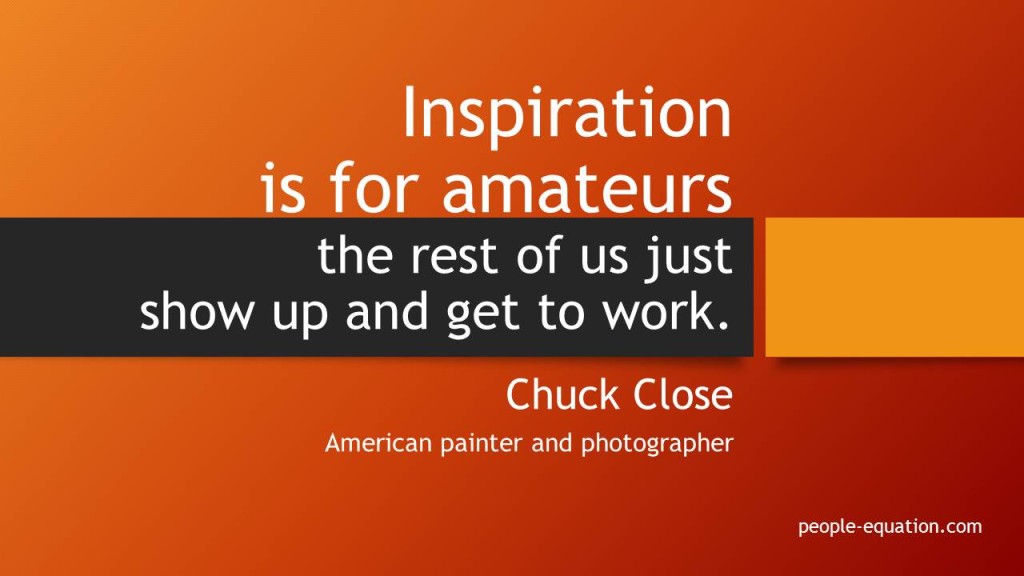 I happened upon this quote, ironically, while I was seeking some “inspiration” for my writing. There I was, sitting at my laptop, surrounded by volumes of notes and online research, with the cold, paralyzing fingers of writer’s block starting to twine themselves around my synapses.
I happened upon this quote, ironically, while I was seeking some “inspiration” for my writing. There I was, sitting at my laptop, surrounded by volumes of notes and online research, with the cold, paralyzing fingers of writer’s block starting to twine themselves around my synapses.
Nothing was coming to me. Where the heck was my inspiration for all the writing I’d planned to do on this day?
Like Archimedes shouting “Eureka!” during his bath, we think profound thoughts will happen upon us suddenly, and at our beckoning. Oh, if only we could conjure the muse so easily!
But it rarely works this way. As artist Chuck Close so wisely points out, amateurs wait for the inspiration to strike. Professionals show up and get to work. Seth Godin called it “shipping” in his book Linchpin: just get something moving, even if it’s not perfect.
Feeling stuck? Here are four ways to help stir your creative juices:
Take a walk. Get up out of your chair and move your body. Even a quick walk down the hall will make a difference. Research reported on the Medical Daily site indicates that walking itself (as compared to sitting still for an entire mental task) can improve creativity up to 60 percent. Moreover, the mental distance that you create when you step away from the task for a few minutes can also help stimulate creativity. That’s what I did when I realized I wasn’t “in the flow” and that’s when the inspiration for this series on inspiration hit me. Yes, it really can be that easy.
Do the opposite. Are you trying to do something physical? Switch it up and do something mental. Or vice versa. This stimulates different areas of your brain and allows a “reboot” in creativity. The more you challenge your brain, the greater the opportunity to create new pathways. Neurobiologist Lawrence Katz coined the term “neurobics,” meaning to engage different parts of your brain to do familiar tasks. For example, try brushing your teeth with the opposite hand or eating dinner with your eyes closed.
Stretch. If it’s not possible to get out of your office, you can still give yourself a mental boost. Stretching reduces stress and improves concentration. Try this series of “covert” exercises that you can do discreetly at work. Nobody will notice and you’ll be more energized!
Crowd source. Feeling stuck? Ask a friend! It’s amazing that when I reach out to others and pose a question, that just the right “nudge” will come my way to help me get back on track. Pick up the phone: invite a colleague to lunch. Hop onto Facebook and post a question, or send an email to a few friends to ask their advice. A quick touch-base with people you know and trust often reaps way more rewards than hours of research.
Meeting deadlines is a reality of work life; when we’re under this pressure, we feel compelled to push ahead. Ironically, I find that the harder I push, the less inspired I get. It’s almost as if my brain is pushing back and saying, “Sorry, Jen, it’s not going to happen right now.” Most of the tips listed above don’t take a lot of time and they free up the mind to have a little “breathing space.” When I switch gears in some way, that’s when my thinking becomes unblocked and I can once ahead move on with my project.
Your turn: what’s your favorite tip for becoming inspired on a work project?
Karin,
Yes, I’ve turned to crowdsourcing more frequently as of late and with great benefit. It definitely builds relationships and stretches thinking.
Jane,
Glad this post struck a chord with you. Good luck as you search for the “light” at the end of tunnel . . .I know it’s there!